Glamour Accessories of the 1950s
The pointed pre-formed conically stitched bra was actually a fashion accessory, as without one the sweater girl look was certainly not right. Fashionable accessories included popper beads and spectacles with enormous wings that arched upward in twirls that could be studded with rhinestones.
Eyewear and Fifties Look Spectacles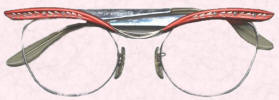
One unexpected facial accessory of 50s was spectacles. Frequently these were inlaid with diamante or scattered glitter dust. The exaggerated wings at the outer corners flared in the style of butterfly wings.
Think of the Australian entertainer Dame Edna Everage and you have the essence of the spectacles, although somewhat exaggerated. Here is a realistic example of 1950s spectacles and shown right.
950s Hats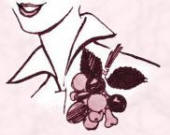
Hats added the final touch of 1950s glamour to a woman or girl's outfit, particularly in the early fifties. Last year's dress or suit could be updated easily with a new hat or a fresh ornament such as flowers, an autumnal bunch of acorns and leaves, or a bunch of cherries.
Corsage made of fruits. Similar items were used to trim hats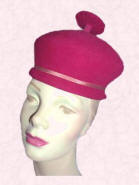
Balenciaga had first shown the pillbox and it became the hat of the fifties and later the hat of the sixties when it was greatly favoured by Jackie Kennedy. The pillbox often had veiling attached as shown in the header.
Neat pillbox style hat image left is courtesy of anothertimevintageapparel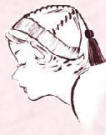
In the mid fifties glorious hat styles covered less in plumage and more in floral blooms appeared. Some designs consisted solely of bomb like shapes covered with flower petals, almost like a more full blown version of the swimming cap above. Later hats consisted of folds of tulle, organza, nets or swirls of georgette.
Other simple hats included neat beret varieties and also knitted beret hats with tassels or pom-pom. 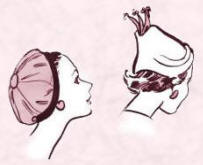
The jester 4 cornered beret hat was made of felt and velvet and available in a riot of glorious colours and was priced at one guinea or 21 shillings.
The head hugging Baker Boy beret was in a fabric called suedeen and jersey for 22/-.
Generally hats began to lose favour in the fifties as they were unsuitable for the new hairstyles. Women spent more time at the hair salon and the last thing they wanted to do was spoil their latest hairdo with a hat. Fashionable hairstyles began with simple ponytails and ended the decade with complex beehive arrangements.
Milliners could have designed hats more suitable for the new fuller bouffant hairstyles, but they failed to see the possibilities and designs continued as before and they lost the market for hats eventually.
Fifties Glamour with Cosmetics
In the 1950s, colour films made an enormous impact on cosmetics. The huge cinema screens illuminated the unblemished appearance of stars and caused the make up artist Max Factor to invent an everyday version of the foundation he used called "Pan Cake". This was a makeup to gloss over skin imperfections. He also brought out a range of eye shadows and lipsticks which helped create the 1950s glamour.
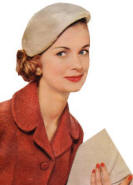 Later in the 50s titanium was added to tone down the brightness of products and this resulted in lips with a pale shimmering gleam.
Later in the 50s titanium was added to tone down the brightness of products and this resulted in lips with a pale shimmering gleam.
Magazines taught step by step how to use recently introduced lip brushes and young girls began to blend and mix their own lip colours often having first blotted the lips out with Max Factor Pancake make up.
The idea was extended to create frosted nail varnishes of pink, peach, silver and a host of other colours but in this 1955 image below you can see the colour to wear was red. The model below shows scarlet fingernails and lips and finishes off her outfit with a smart beret.
Left 1955 Makeup & Manicure
In the late 50s the make up company Gala had introduced pale shimmering lipsticks with added titanium. Later Max Factor brought out a colour called Strawberry Meringue which was a pastel pearly pink. They really caught on in the late fifties and early sixties as young girls were frowned upon if they wore brazen red lips, so the softened pink and peach colours were acceptable initially to parents and then became a trend.
As the fifties ended, Vogue magazine had started to coordinate the colour's of the season's latest clothes with those of the cosmetics on offer. Eventually all the make up houses followed, producing ranges that picked up colour changes.
1950s Gloves - the Order of the Day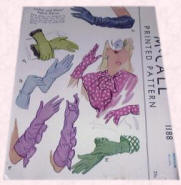
Gloves were worn everywhere in the 1950s and completed a woman's grooming. Without gloves she was not properly accessorised. Clean gloves were also the hallmark of a lady and white or cream were the most favoured gloves.
Gloves worn in so many colours were usually made of cotton as this was more affordable than leather gloves or the newer nylon and they could be washed very easily. Even so many women owned a special pair of leather gloves. You can see from the picture right, why they were sometimes referred to as 1950s Gauntlet Gloves.
Dents and Pittards were popular glove names, but women could also make their own gloves using a McCall's pattern such as this vintage pattern above from anothertimevintageapparel.
The formality of wearing gloves even continued into the sixties with interesting cut out peephole variations in the popular stretch nylon and designed almost like a golfing glove. By the 1970s gloves were more used functionally for keeping the hands warm than for any other reason.
1950s Bags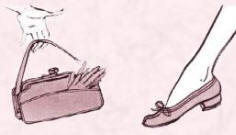
Bags in the 1950s were literally handbags and usually held by the hand or over the arm in the fashion followed by Grace Kelly who used her Hermes bag to hide her pregnancy. Many handbags had side pockets, or even grip clasps or rings for a woman to keep track of her gloves. Right - 1955 Handbag and Flat shoes.
Larger bags to hold possessions were also popular when women travelled using public transport some distance into towns. They could keep all their essentials with them as very few women realistically had regular car access in those days in UK.
Bucket bags and raffia bags were also useful accessories as winkle picker stiletto shoes were not so comfortable. Often a pair of flat shoes lurked in the bags out of necessity just in case entrance was forbidden. Carpet was not universally used then in buildings and many floors of the period were linoleum or wood tiled and the stilettos indented the tiles easily.
Early 1950's Shoes
Early 1950's shoes were often very high, but with rounded or peep toes and low cut front uppers and sometimes had sturdy Cuban heels. Strapped sandals with finer heels were popular as were heavier thicker heels for lower shoes, but by the mid fifties kitten heels and metal tipped steel stiletto heels replaced styles that owed more to designs that had been brought out to compliment the New look of 1947.
Stiletto Heeled Pointed Toe 1950's Shoes
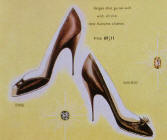 By the mid 1950s pointed toe shoes called winkle pickers with stiletto heels up to 5 inches were a common sight. There is no doubt that the trademark of the fifties was the stiletto heeled shoe, first seen in 1952 at a Dior fashion show.
By the mid 1950s pointed toe shoes called winkle pickers with stiletto heels up to 5 inches were a common sight. There is no doubt that the trademark of the fifties was the stiletto heeled shoe, first seen in 1952 at a Dior fashion show.
Left - 1955 Old Dolcis Advert for stiletto heeled shoes at 69/11d.
Below is a picture of the spiked umbrella so popular in the 50s and 60s.
The long slim umbrella was available in many bright colours and price 28 shillings and sixpence.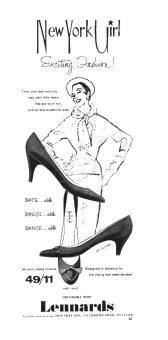
Almost as if to match the spindly heel, umbrellas were elongated with 6 inch steel spikes and many a woman considered a furled umbrella as protection from attack when walking home late at night. Taxis were not only a rarity, but also a luxury in the fifties.
Many a floor was ruined by stilettos from shoes and umbrellas. The main problem was caused by the stilettos being metal tipped as still somewhat economy conscious after the war British wearers preferred the longer life of steel than rubber tips, despite the click clacking irritating noise they made.
So stilettos became banned in many buildings and remain banned in National Trust properties and stately homes. So take your spare flat shoes if visiting such places, as the stiletto sandals and shoes of 2005 often bear a very similar look to 50's footwear.
Teenagers
Until 1950 the term teenagers had never before been coined. Children were known as girls and boys were known as youths once they displayed signs of puberty. Then young people were grown up at 18 and fully adult legally at 21 when they often married and set up a home of their own, even if it was a rented room. Getting married was a way of showing the adult world that you belonged to their world and was a way of escape from puberty.
1950's Teenage Consumers
During the 1950s a range of influences including film, television, magazines and the rock music scene created a new market grouping called teenagers. Teens made themselves known. A sudden flurry of consumer goods denied to war torn Europe were available and a consumer boom was actively encouraged.
These single young people with cash from paid work soon had their own fashions, own music, own cafes, own milk bars and by the end of the decade even their own transport in the form of fuelled scooters. Teenagers suddenly dominated style in clothes, haircuts and even travel abroad. A generation gap began to emerge between parents and teen offspring. It seemed almost unholy at the time and was viewed as rebellious, but compared to later anti-fashion and anarchic movements it was all rather innocent.
Teenage Fashion Idols
American influence on European teenagers was huge. Rock and Roll idols including Elvis Presley, Bill Hayley, Jerry Lee Lewis and film stars James Dean and Marlon Brando set fashions almost unwittingly. The main looks for teenagers were greasers and preppies.
Greasers followed the standard black leather and denim jeans look set by Marlon Brando in "The Wild One" (1953) and later emulated in the 1978 film called "Grease". They raced about town on motorbikes and were consider outrageous.
Preppie qualities were neatness, tidiness and grooming. Teen girls wore full dirndl or circular skirts with large appliqués on their clothing. Neat pleated skirts were also popular. The pleated skirts were made from a then new fabric called TERYLENE (polyester) which helped maintain razor sharp sunray pleating.
As the site is about female dress my interest in developing male dress entries is very limited. Even though this site does not really deal with male dress, the Teddy Boy was an important look in fashion history of the 1950s. As an extreme look it is remembered and all conventional looks of the day tend to be overlooked. It is worth remembering that when costume history documents a look it is almost ways in retrospect and hones in on the final extremes of any look.
A site visitor recently wrote to tell me that he felt the teddy boy style originated in the forties by spivs and was then taken up by teenagers in the very early 50's. He maintains that the Teddy Boy clothes of the early fifties would not be recognised as a Teddy Boy by most people today. So here are a few points below on the memorable extremes of the teddy boy look.
It is known that in England, a group of young men who rejected the shabby, but functional clothes styles worn by their fathers began to long for elegant fashions. From around 1949 this was expressed as a liking for Edwardian style velvet trimmed skirted coats and specific accessories. This fashion is thought to have really originated when 500 Jamaicans arrived in Tilbury in 1948 on board the ex troop ship "Empire Windrush" in response to the UK's government plea to the Caribbean for workers. They wore Zoot suits and the Edwardian look is thought to have been an adaptation of the suit the Jamaicans were seen wearing about the East End towns.
Until 1951 the Edwardian look suits were custom made. In August 1951 reports state that the Edwardian look was gaining support in America. By November 1951 the Edwardian look had percolated to the UK factory tailoring trade as a new trend.
By 1952 in London's East End this fashion was taken on by semi skilled adolescents formed groups, who lurked in cafes and hung around street corners. The self imposed uniform that gave them group identity was that of the Teddy Boy. Even though some groups were violent, many who wore Teddy Boy clothes were not. They simply wished to break away from the conforming clothes of the day. 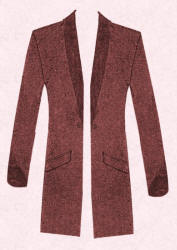
Traditionally Teddy Boys or Neo-Edwardians sported the "Drape" a long knee length, single breasted wool jacket with narrow contrasting lapels and cuffs either of velvet or satin and plenty of pockets. They wore contrast or matching narrow drainpipe trousers, brocade waistcoats, stiff shirts and shoestring ties or bootlace slim Jim ties topped off with suede shoes. Teds also wore crepe soled shoes which helped with the dance movements of jiving.
Teddy Boy clothes were not cheap to buy and when custom tailored, usually cost up to £100 for one outfit. An ordinary mass produced drape suit cost approximately £20 and shoes £3. So sporting a new suit indicated to peers how well an individual was doing money wise. At this time a Teddy Boy would have earned between £5 and £12 a week.
A site visitor has written to tell me some fifties facts - The 'Crape' sole shoes originated during the second world war and looked nothing like the Brothel Creepers seen in the 50's, George Cox the company who first made the Brothel Creeper is still in business and making the Creeper.
The boys slicked back their hair with Brilliantine into a wavy Quiff style with long sideburns and because of the way the hair was finished to the back of the head, the style was brushed back to meet in the middle with the finishing touch of a comb run down the centre back ,thus giving the look of a DA (ducks arse). The most common Hair cut was called a Tony Curtis taken from the way he wore his hair. 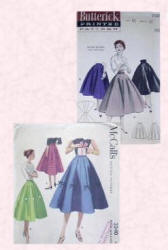
Lots of Teddy Boys had Bikes in the fifties, the rocker style was born from the Teds who wore Drapes at weekends but leathers on the bike, by the early 60's Rockers were a major style. A trip to the Ace Cafe in London is well worth a visit to learn about Rockers. (Thanks to Chris for input on these few paragraphs).
The fashion for Teddy Boy clothes spread across the world, even to the USSR. In the USA teen fashion fads were paralleled by youths who wore leather jackets instead of a drape, sometimes leather trousers, but often jeans, all accessorized with a shiny motorbike. The film West Side Story captures this era perfectly as does the later retrospective film Grease.
These skirt pattern images are courtesy of anothertimevintageapparel and are typical of the full skirts worn by teddy girls for rock n'roll or jiving.
The pony tailed girlfriends of Teds wore eye make up and took every fashion to excess. Their favourite outfit was a close fitted black sweater and calf length skirt, or toreador pants or circle skirts with low cut tops all perfect to display the body when dancing.

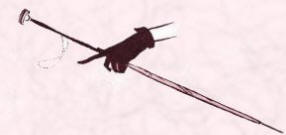
No comments:
Post a Comment